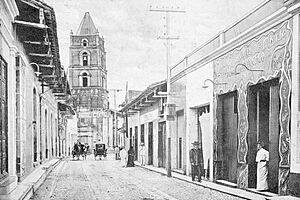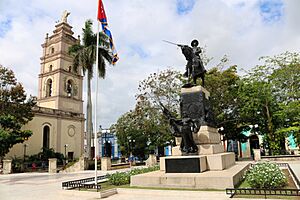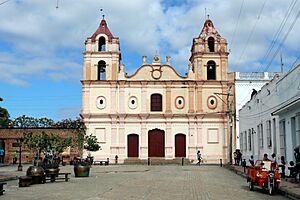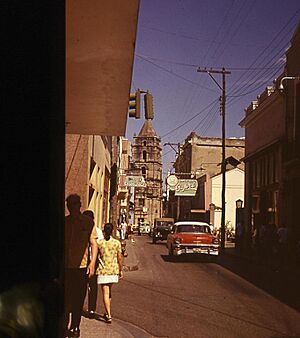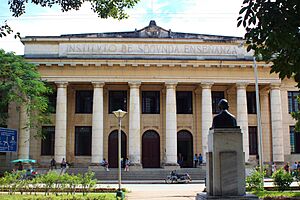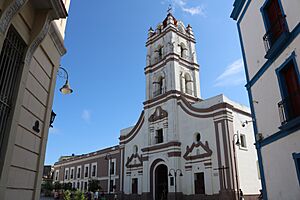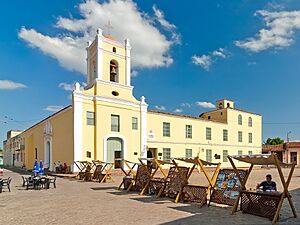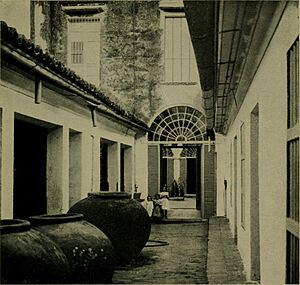Camagüey facts for kids
Quick facts for kids
Camagüey
|
||
|---|---|---|
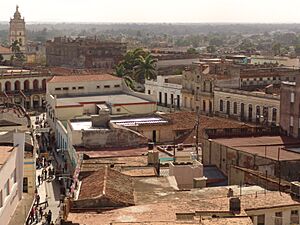 |
||
|
||
| Nickname(s):
City of the Big Jars (Ciudad de los Tinajones)
|
||
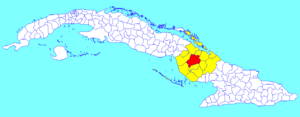
Camagüey municipality (red) within
Camagüey Province (yellow) and Cuba |
||
| Country | Cuba | |
| Province | Camagüey | |
| Founded | 1528 | |
| Area | ||
| • City | 1,106 km2 (427 sq mi) | |
| Elevation | 95 m (312 ft) | |
| Population
(2022)
|
||
| • City | 333,251 | |
| • Density | 301.31/km2 (780.4/sq mi) | |
| • Urban | 313,216 | |
| Demonym(s) | Camagüeyano | |
| GDP (PPP, constant 2015 values) | ||
| • Year | 2023 | |
| • Total | $4.0 billion | |
| • Per capita | $12,900 | |
| Time zone | UTC-5 (EST) | |
| Postal code |
70100
|
|
| Area code(s) | +53 322 | |
| Climate | Aw | |
| Website | http://www.camaguey.gob.cu/es/ | |
| UNESCO World Heritage Site | ||
| Official name | Historic Centre of Camagüey | |
| Criteria | Cultural: iv, v | |
| Inscription | 2008 (32nd Session) | |
| Area | 54 ha (0.21 sq mi) | |
| Buffer zone | 276 ha (1.07 sq mi) | |
Camagüey (pronounced kama-GWAY) is a large city and municipality in central Cuba. It is the third-largest city in the country, with over 333,000 people living there. Camagüey is also the capital city of the Camagüey Province.
The city was first started by Spanish settlers in 1514. It was called Santa María del Puerto del Príncipe and was located on the northern coast. Later, in 1528, it was moved inland to where a Taino village named Camagüey used to be. It was one of the first seven towns the Spanish built in Cuba.
In the 1600s, a pirate named Henry Morgan attacked and burned the city. After this, the city was rebuilt with a confusing, maze-like street plan. This was done to make it harder for attackers to move around inside the city.
A special symbol of Camagüey is the tinajón. This is a large clay pot used to collect rainwater and keep it cool. You can see these pots all over the city! Camagüey is also the hometown of Ignacio Agramonte (born 1841). He was an important leader in the Ten Years' War against Spain.
In 2008, the old part of Camagüey was named a UNESCO World Heritage Site. This means it's a very special place because of its unique street plan, its role in Spanish history, and its beautiful old buildings.
Contents
History of Camagüey
Camagüey was first founded on February 2, 1514. Spanish settlers, led by Diego Velázquez de Cuéllar, started the town. It was first located on the northern coast, in an area now called Nuevitas. This was one of the first seven towns the Spanish built in Cuba. In 1528, the settlement was moved inland to the site of an old Taíno village named Camagüey.
Why the Maze-Like Streets?
The new city was built with a very confusing layout. It has winding alleys, many dead ends, and streets that split off into different-sized squares. Some people believe this was done on purpose. The idea was to make it harder for pirates or other attackers to find their way around the city. They also say there was only one main exit, so if attackers got in, the locals could trap them.
However, many local people say this is just a story. They believe the city simply grew without a master plan. They say the winding streets happened because everyone wanted to live close to their local church. The city has 15 churches!
In the 1700s, the city was still called Santa María del Puerto del Príncipe. Between 1747 and 1753, Luis de Unzaga helped rebuild the city. It had been badly damaged during a war. He also rebuilt the Church of La Merced.
When Cuba became independent from Spain in 1898, the city and its surrounding province got their current name: Camagüey. This name came from an old local chief, or cacique, named Camagüebax. He ruled the area between the Tínima and Hatibonico rivers.
Geography and People
Camagüey is located on a flat plain in the middle of its province. It shares borders with several other towns and municipalities.
In 2022, about 333,251 people lived in Camagüey. The city covers an area of about 1,106 km2 (427 sq mi). This means it has about 300/km2 (780/sq mi) people per square kilometer.
Culture and Symbols
The most famous symbol of Camagüey is the clay tinajón, or big pot. These pots were used to collect rainwater and keep it cool and fresh. You can see them everywhere in the city, from small ones to huge ones that are like monuments.
There's a local legend about the tinajón: "Quien tome agua del tinajón, en Camagüey se queda." This means, "Whoever drinks water from the tinajón will stay in Camagüey." It suggests that if you visit, you'll fall in love with the city and its people and never want to leave!
Historians say the Spanish brought the idea of these jars to Cuba. They were used in Spain to store things like wine and olive oil. In Camagüey, they became a great way to deal with water shortages. People would place them under gutters to catch rainwater. The pots were often buried halfway in the ground to keep the water cool. Soon, making these pots became a local craft. The more beautiful and numerous the tinajones a family had, the wealthier they were considered.
City Life and Buildings
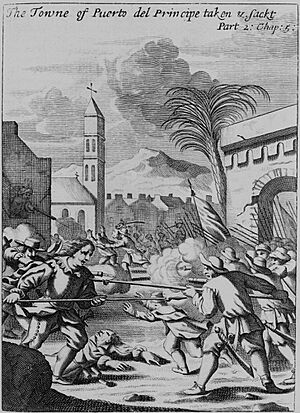
Street Layout
The old part of Camagüey looks like a real maze. Its streets are narrow and short, always turning in different directions. This design was made after Henry Morgan attacked the city in the 1600s. The goal was to make it hard for attackers to find their way around.
Architecture

Camagüey is a World Heritage Site because of its unique colonial buildings and maze-like streets. The city has more than 30 Catholic churches, which show its long history under Spanish rule.
Some important churches include:
- The "Church of Nuestra Señora del Carmen" is a beautiful church with two towers, finished in 1825.
- The Cathedral of Camagüey started as a small chapel in 1530 and was completed in 1864.
- The "Church of Nuestra Señora de la Soledad" is a very symbolic church built in the 1700s. Inside, it has decorated frescoes, and it's where the hero Ignacio Agramonte was baptized.
- The "Church and Convent-Hospital San Juan de Dios" was built between 1736 and 1755. It has a unique altar showing the Holy Trinity as three human figures, which is the only one like it in Cuba.
- The "Church of Santa Ana" has been mentioned in documents since 1617, showing it's one of the oldest.
- The "Church of Nuestra Señora de la Caridad" was built to honor the patroness of Cuba. It became a parish church in 1801.
- The "Church del Sagrado Corazón de Jesús" is a newer church, built between 1912 and 1919 in a Gothic style.
The Gran Hotel Camagüey, a famous building, opened in 1938.
Transport
Camagüey has an important train station. It's on the main line that connects Havana to Santiago de Cuba. The city is also crossed by the Carretera Central highway and has a beltway around it.
- Airports
Camagüey has its own international airport, Ignacio Agramonte International Airport. It's located just outside the city. Many tourists flying to or from the Beach of Santa Lucía use this airport.
Climate
Camagüey has a tropical savanna climate. This means it's generally hot, with a wet season and a dry season. Afternoon temperatures are warm to hot all year. Mornings are mild to warm. The most rain falls in June, and the least in February.
Cuba often experiences tropical cyclones, which are strong storms. Camagüey has been affected by them many times, like the big hurricane in 1932.
| Climate data for Camagüey | |||||||||||||
|---|---|---|---|---|---|---|---|---|---|---|---|---|---|
| Month | Jan | Feb | Mar | Apr | May | Jun | Jul | Aug | Sep | Oct | Nov | Dec | Year |
| Record high °C (°F) | 32.8 (91.0) |
34.4 (93.9) |
36.7 (98.1) |
37.8 (100.0) |
38.9 (102.0) |
38.3 (100.9) |
37.8 (100.0) |
38.9 (102.0) |
36.7 (98.1) |
36.1 (97.0) |
33.9 (93.0) |
33.9 (93.0) |
38.9 (102.0) |
| Mean daily maximum °C (°F) | 27.2 (81.0) |
28.3 (82.9) |
30.0 (86.0) |
31.7 (89.1) |
31.7 (89.1) |
31.7 (89.1) |
32.8 (91.0) |
32.8 (91.0) |
32.2 (90.0) |
30.6 (87.1) |
28.9 (84.0) |
27.8 (82.0) |
30.5 (86.9) |
| Daily mean °C (°F) | 22.2 (72.0) |
23.1 (73.6) |
24.5 (76.1) |
25.8 (78.4) |
26.4 (79.5) |
26.7 (80.1) |
27.5 (81.5) |
27.5 (81.5) |
27.0 (80.6) |
25.8 (78.4) |
24.2 (75.6) |
22.8 (73.0) |
25.3 (77.5) |
| Mean daily minimum °C (°F) | 17.2 (63.0) |
17.8 (64.0) |
18.9 (66.0) |
20.0 (68.0) |
21.1 (70.0) |
21.7 (71.1) |
22.2 (72.0) |
22.2 (72.0) |
21.7 (71.1) |
21.1 (70.0) |
19.4 (66.9) |
17.8 (64.0) |
20.1 (68.2) |
| Record low °C (°F) | 7.8 (46.0) |
9.4 (48.9) |
11.1 (52.0) |
13.9 (57.0) |
13.3 (55.9) |
16.7 (62.1) |
18.9 (66.0) |
18.9 (66.0) |
17.8 (64.0) |
15.6 (60.1) |
10.0 (50.0) |
7.2 (45.0) |
7.2 (45.0) |
| Average rainfall mm (inches) | 38.1 (1.50) |
35.6 (1.40) |
61.0 (2.40) |
91.4 (3.60) |
193.0 (7.60) |
266.7 (10.50) |
142.2 (5.60) |
139.7 (5.50) |
185.4 (7.30) |
137.2 (5.40) |
78.7 (3.10) |
50.8 (2.00) |
1,419.8 (55.90) |
| Source: Sistema de Clasificación Bioclimática Mundial | |||||||||||||
Sports and Education
Sports Teams
Camagüey has a local baseball team called Toros de Camagüey. Their nickname is Alfareros, which means "Potters." They play at the Estadio Cándido González. The city also has a soccer team, FC Camagüey, which plays at the Estadio Patricio Lumumba.
Schools and Universities
The most well-known high school in Camagüey is the "Instituto Pre-Universitario Vocacional de Ciencias Exactas" (IPVCE) Máximo Gómez Báez. It's often called the "Vocational School." This is the largest school of its kind in the province. Students who want to go to this school must pass an entrance exam after finishing middle school (grades 7-9). They then study for three more years to prepare for college.
Cuba's school system is a bit different from some other countries. What is called "High School" (grades 9-12) in the United States is split into "Secundaria" (grades 7-9) and "Pre-Universitario" (grades 10-12) in Cuba. Some other important secondary schools in Camagüey include La Avellaneda and Javier de la Vega. There are also special schools for athletes, artists, and a military high school.
The University of Camagüey is located in the city. It offers programs in engineering, science, and humanities. There's also a separate university for medical education, the Carlos J Finlay University of Medical Science. Since 2016, the University of Camagüey has combined with the Sports University and the Pedagogical Sciences University. It now has over 12,000 students and 3,000 professors.
Famous People from Camagüey
Many notable people were born in Camagüey:
- Ignacio Agramonte (born 1841) was a very important figure in Cuba's fight for independence from Spain (1868-1878). He helped write Cuba's first constitution in 1869. As a military leader, he formed a famous cavalry group that fought bravely against the Spanish. A monument to him, showing him on horseback, stands in the park named after him.
- Tony Pérez is a famous baseball player who is in the Baseball Hall of Fame. He won two World Series titles with the Cincinnati Reds.
- Nicolás Guillén was a well-known Cuban national poet.
- Carlos J. Finlay was an amazing doctor and scientist. He was the first to figure out that the Aedes aegyptis mosquito carries yellow fever.
- Mireya Luis is a famous volleyball player.
- José Olallo Valdés was a religious figure who worked in Camagüey and was later recognized as a saint.
- Jorge Gutiérrez Espinosa is an Olympic champion boxer who won a gold medal in Sydney in 2000.
- Luis Ortiz (born 1979) is a professional boxer.
- Lope Recio Loynaz was the first Governor of Camagüey Province after Cuba became a republic.
- Artists like José Iraola, Roberto Estopiñán, and Juan Boza were born here.
- Poets and writers like Brígida Agüero, Domitila García de Coronado, Emelina Peyrellade Zaldívar, and Raúl Rivero also came from Camagüey.
- Gertrudis Gomez de Avellanada (poet) and Silvestre de Balboa (writer) are also from the city.
- Salvador Cisneros Betancourt was a Cuban patriot and president of the Cuban Republic in Arms.
Images for kids
-
Plaza de la Revolución Ignacio Agramonte.
See also
 In Spanish: Camagüey para niños
In Spanish: Camagüey para niños



